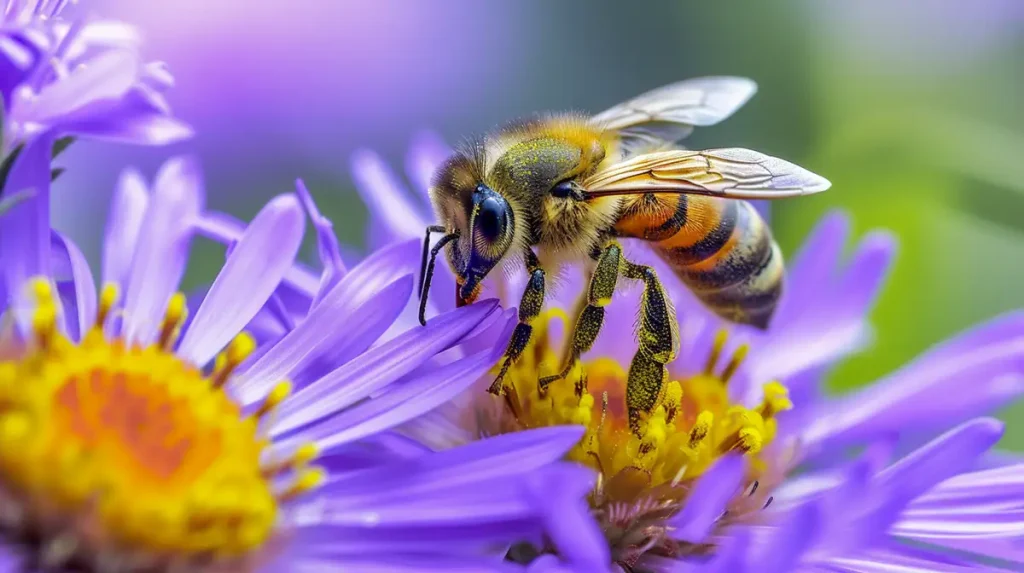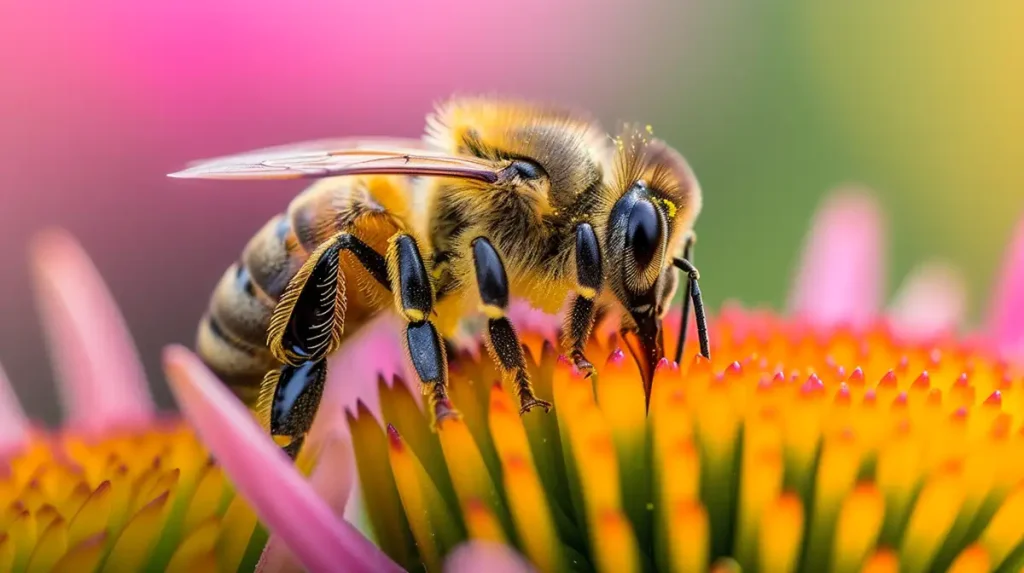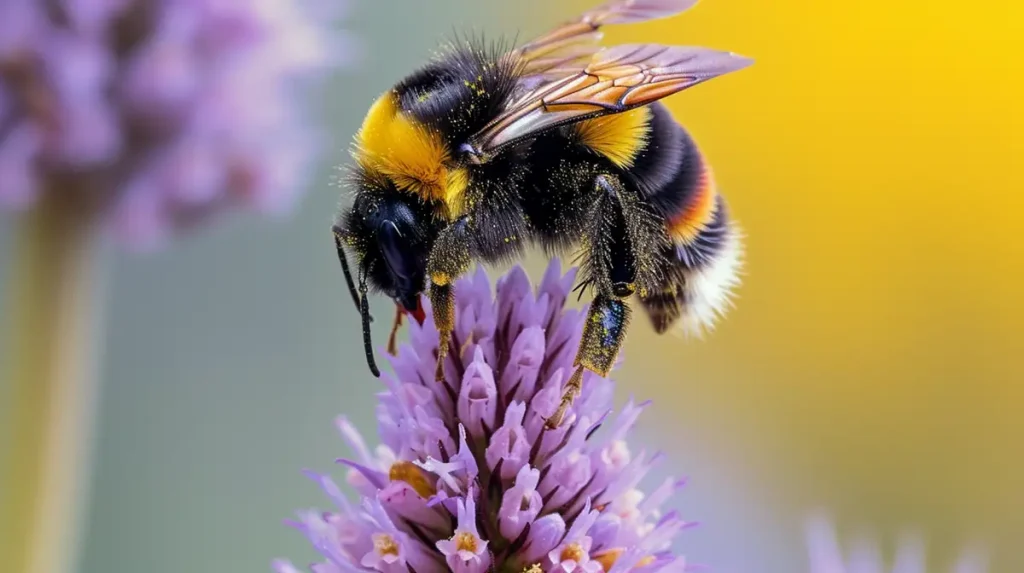Table of Contents
A bee possesses a total of five eyes. This includes two large compound eyes on the sides of its head and three smaller ocelli eyes located on the top of its head.
In the below paragraphs, we will take a more detailed look at this topic.
Insects possess a unique characteristic that sets them apart from humans and most other animals – they have more than two eyes. A bee, for instance, has five eyes. This intriguing feature raises the question of why bees have so many eyes and what purpose they serve. The answer to these questions will be explored in depth later in the article.
How Many Types of Eyes Does a Bee Have?
Bees possess a fascinating and intricate visual system that enables them to navigate, forage, and communicate with their colony. They have two different types of eyes: compound eyes and ocelli.
Compound Eyes
The most prominent and well-known eyes of a bee are its two large, multifaceted compound eyes. Each compound eye is made up of thousands of individual units called ommatidia. These ommatidia work together to form a mosaic-like image of the bee’s surroundings, allowing it to detect colors, movement, and patterns. Bees are capable of seeing ultraviolet (UV) light, which is invisible to humans. This helps them identify flowers and other resources more efficiently.
Ocelli
In addition to the compound eyes, bees also have three small, simple eyes called ocelli located on the top of their head. These eyes are primarily responsible for detecting changes in light intensity and assisting with navigation. Ocelli are particularly useful for maintaining the bee’s orientation during flight and determining the position of the sun, even on overcast days. This information helps bees navigate back to their hive and communicate the location of food sources to their fellow colony members using the famous “waggle dance.”

Do All Bees Have the Same Number of Eyes?
While there is some variation in the number of ommatidia within the compound eyes of different bee species, all bees share the same basic eye structure. They have two compound eyes and three ocelli, resulting in a total of five eyes. However, it is essential to note that the size, arrangement, and function of these eyes may differ among bee species due to their specific ecological roles and adaptations.
Variation in Compound Eyes
The number of ommatidia in the compound eyes can vary depending on the species and the bee’s role within the colony. For example, honeybees have approximately 4,000 to 5,000 ommatidia per compound eye, while bumblebees tend to have fewer, around 2,000 to 3,000 ommatidia. In general, male bees and worker bees have different numbers of ommatidia because they perform distinct tasks in the colony. Male bees, or drones, usually have larger compound eyes with more ommatidia to better locate and pursue queen bees during mating flights.
Consistent Number of Ocelli
The number of ocelli remains consistent across bee species, with all bees possessing three ocelli. These simple eyes are crucial for detecting changes in light intensity and assisting with navigation, as mentioned earlier. Although the number of ocelli is constant among bee species, their size and sensitivity may vary.

How Do Bees See the World?
Bees see the world slightly different to humans, particularly in terms of the colors they can see. Humans see wavelengths that range from 390 to 750 nanometers. This range affects the colors that we see. Bees see wavelengths ranging from 300 to 650 nanometers, which means that they cannot see the color red. However, they can see ultraviolet light.
Vision is more important to bees than smell, and it is vision that they use to guide them to the nectar they are collecting. Many flowers have ultraviolet patterns designed to attract pollinators such as bees. The patterns are often referred to as ‘landing zones’ as they are similar to runway lights that guide airplanes into land. The patterns on flowers guide the bees to the nectar. Smell is something that bees focus on only when they are already close to a flower.
How Does a Bee’s Vision Compare to Humans?
While both bees and humans rely on their vision to navigate and interpret their surroundings, there are significant differences between a bee’s visual system and that of a human. The main differences lie in the perception of color, visual acuity, and field of view.
- Carter, Anthony (Author)
- English (Publication Language)
- 194 Pages - 02/28/2024 (Publication Date) - Independently published (Publisher)
Color Perception
Humans typically perceive color through three types of photoreceptors called cones, which are sensitive to red, green, and blue wavelengths of light. This trichromatic vision allows humans to see a broad spectrum of colors. Bees, on the other hand, possess a different type of color vision. They have three types of photoreceptors as well, but they are sensitive to ultraviolet (UV), blue, and green wavelengths. This means that bees can see UV light, which is invisible to humans, and perceive colors differently. For example, bees can’t see the color red, but they can distinguish various shades of yellow and blue that humans cannot.
Visual Acuity
Visual acuity refers to the ability to discern details and resolve fine patterns. In this aspect, human vision is superior to that of bees. The compound eyes of bees create a mosaic-like image composed of the individual ommatidia, resulting in lower visual acuity compared to humans. Nonetheless, this lower acuity is compensated by the bee’s ability to detect rapid movement, which is crucial for locating flowers and evading predators.
Field of View
The compound eyes of bees provide a wide field of view, enabling them to see almost 360 degrees around them. This is a significant advantage when it comes to detecting predators, navigating, and foraging. In contrast, humans have a much narrower field of view, roughly 180 degrees, with only about 120 degrees of that being binocular vision, where both eyes contribute to the perception of depth.

How Many Eyes Does a Bee Have – In Summary
Bees have five eyes; two of them are found on the side of their heads and are known as compound eyes. The other three ocelli eyes are arranged in a triangle shape on the back of the bee’s head. Bees use their eyes to see the world around them as opposed to relying just on smell to guide them around. Their compound eyes are comprised of thousands of tiny lenses which all see the surrounding area from a different angle. When all the images are pieced together, the bees see a whole picture. Ocelli eyes are used to help with navigation and orientation.
FAQs
Q: Can bees see in the dark? A: Bees are not able to see in complete darkness, but their compound eyes are sensitive to low light levels. They also use their sense of smell and memory to navigate in the dark.
Q: How do bees clean their eyes? A: Bees clean their eyes by using their front legs to brush away any dirt or debris that may have gotten on them. They also have special glands that produce a liquid that helps to clean and lubricate their eyes.
Q: Are bees nearsighted or farsighted? A: Bees are nearsighted, which means they have trouble seeing things that are far away.
Q: How do bees communicate with each other using their eyes? A: Bees communicate with each other using a series of movements known as the “waggle dance.” The dance communicates the direction and distance of a food source, and it relies on the bees’ ability to see each other’s movements with their compound eyes.
Q: Can bees see polarized light? A: Yes, bees can see polarized light, which allows them to navigate using the patterns of polarized light in the sky.
Q: Do male and female bees have the same number of eyes? A: Yes, both male and female bees have five eyes.
Q: Do bees have eyelids? A: No, bees do not have eyelids. Instead, they have a clear covering over their eyes called a cornea.
Q: How do bees protect their eyes? A: Bees protect their eyes by using their front legs to clean them and by producing a liquid that helps to clean and lubricate their eyes. They also have a hairy body that helps to protect their eyes from dust and debris.
Q: Can bees see in 3D? A: Yes, bees can see in 3D. Their compound eyes allow them to perceive depth, which is important for navigating their environment and finding flowers.
Q: Do bees’ eyes change as they age? A: Yes, bees’ eyes change as they age. As they get older, their eyesight becomes less acute, and their ability to detect colors may diminish.
Q: Do bees have a blind spot? A: Yes, bees have a blind spot in the center of their vision, which is caused by the position of their antennae. However, this does not significantly impair their ability to see.
Last update on 2024-04-25 / Affiliate links / Images from Amazon Product Advertising API


